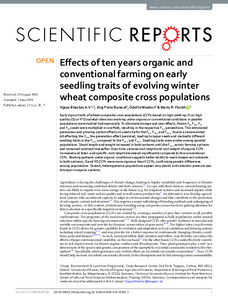Aufsatz

Effects of ten years organic and conventional farming on early seedling traits of evolving winter wheat composite cross populations
Zusammenfassung
Early vigour traits of wheat composite cross populations (CCPs) based on high yielding (Y) or high quality (Q) or Y*Q varietal intercross evolving under organic or conventional conditions in parallel populations were studied hydroponically. To eliminate storage and year effects, frozen F6, F10, F11 and F15 seeds were multiplied in one field, resulting in the respective Fx.1 generations. This eliminated generation and growing system effects on seed size for the F6.1 F10.1 and F15.1. Due to a severe winter kill affecting the F11, the generation effect persisted, leading to larger seeds and markedly different seedling traits in the F11.1 compared to the F10.1 and F15.1. Seedling traits were similar among parallel populations. Shoot length and weight increased in both systems until the F11.1 across farming systems and remained constant thereafter. Over time, seminal root length and root weight of organic CCPs increased and total- and specific- root length decreased significantly compared to the conventional CCPs. Rooting patterns under organic conditions suggests better ability to reach deeper soil nutrients. In both systems, Q and YQ CCPs were more vigorous than Y CCPs, confirming genetic differences among populations. Overall, heterogeneous populations appear very plastic and selection pressure was stronger in organic systems.
Zitierform
In: Scientific Reports 9 (2019-06-21) , S. 9053 ; ISSN 2045-2322Förderhinweis
Gefördert durch den Publikationsfonds der Universität KasselZitieren
@article{doi:10.17170/kobra-20190910671,
author={Vijaya Bhaskar, A. V. and Baresel, Jörg Peter and Weedon, Odette Denise and Finckh, Maria Renate},
title={Effects of ten years organic and conventional farming on early seedling traits of evolving winter wheat composite cross populations},
journal={Scientific Reports},
year={2019}
}
0500 Oax 0501 Text $btxt$2rdacontent 0502 Computermedien $bc$2rdacarrier 1100 2019$n2019 1500 1/eng 2050 ##0##http://hdl.handle.net/123456789/11315 3000 Vijaya Bhaskar, A. V. 3010 Baresel, Jörg Peter 3010 Weedon, Odette Denise 3010 Finckh, Maria Renate 4000 Effects of ten years organic and conventional farming on early seedling traits of evolving winter wheat composite cross populations / Vijaya Bhaskar, A. V. 4030 4060 Online-Ressource 4085 ##0##=u http://nbn-resolving.de/http://hdl.handle.net/123456789/11315=x R 4204 \$dAufsatz 4170 7136 ##0##http://hdl.handle.net/123456789/11315
<resource xsi:schemaLocation="http://datacite.org/schema/kernel-2.2 http://schema.datacite.org/meta/kernel-2.2/metadata.xsd"> 2019-09-10T15:22:23Z 2019-09-10T15:22:23Z 2019-06-21 doi:10.17170/kobra-20190910671 http://hdl.handle.net/123456789/11315 Gefördert durch den Publikationsfonds der Universität Kassel eng Urheberrechtlich geschützt https://rightsstatements.org/page/InC/1.0/ 630 Effects of ten years organic and conventional farming on early seedling traits of evolving winter wheat composite cross populations Aufsatz Early vigour traits of wheat composite cross populations (CCPs) based on high yielding (Y) or high quality (Q) or Y*Q varietal intercross evolving under organic or conventional conditions in parallel populations were studied hydroponically. To eliminate storage and year effects, frozen F6, F10, F11 and F15 seeds were multiplied in one field, resulting in the respective Fx.1 generations. This eliminated generation and growing system effects on seed size for the F6.1 F10.1 and F15.1. Due to a severe winter kill affecting the F11, the generation effect persisted, leading to larger seeds and markedly different seedling traits in the F11.1 compared to the F10.1 and F15.1. Seedling traits were similar among parallel populations. Shoot length and weight increased in both systems until the F11.1 across farming systems and remained constant thereafter. Over time, seminal root length and root weight of organic CCPs increased and total- and specific- root length decreased significantly compared to the conventional CCPs. Rooting patterns under organic conditions suggests better ability to reach deeper soil nutrients. In both systems, Q and YQ CCPs were more vigorous than Y CCPs, confirming genetic differences among populations. Overall, heterogeneous populations appear very plastic and selection pressure was stronger in organic systems. open access Vijaya Bhaskar, A. V. Baresel, Jörg Peter Weedon, Odette Denise Finckh, Maria Renate doi:10.1038/s41598-019-45300-1 publishedVersion ISSN 2045-2322 Scientific Reports 9053 9 </resource>
Die folgenden Lizenzbestimmungen sind mit dieser Ressource verbunden:
Urheberrechtlich geschützt

